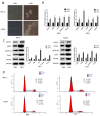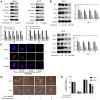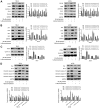Sonic hedgehog pathway mediates genistein inhibition of renal cancer stem cells
- PMID: 31452785
- PMCID: PMC6704282
- DOI: 10.3892/ol.2019.10657
Sonic hedgehog pathway mediates genistein inhibition of renal cancer stem cells
Abstract
Cancer stem cells (CSCs) have been implicated in the genesis, progression and recurrence of renal cancer. The sonic hedgehog (Shh) pathway serves a critical role in maintaining the stemness of CSCs. Genistein, a major isoflavone component extracted from soybeans and soy products, has been demonstrated to possess anticancer activity. However, the effects of genistein on renal CSCs and its underlying mechanisms remain to be fully elucidated. The aim of the present study was to investigate the role of the Shh pathway in genistein inhibition of renal CSCs. The results of the present study demonstrated that expression levels of renal CSC markers were markedly upregulated in the sphere-forming cells, which were isolated and enriched from 786-O and ACHN cells in a tumor sphere formation assay, and more cells were arrested at the G0/G1 phase instead of the S1 phase compared with the adherent cells. Furthermore, the present study demonstrated that genistein could effectively diminish the activity of renal CSCs by suppressing tumor sphere formation, decreasing renal CSCs markers, inhibiting proliferation and inducing apoptosis. Additionally, the downregulation of Shh pathway activity could inhibit renal CSCs. Genistein exhibited an inhibitory effect on renal CSCs by attenuating the activation of the Shh pathway. In conclusion, the results illustrated the role of the Shh pathway in regulating renal CSC traits and the intervention of renal CSCs by genistein, which could provide novel insights into the molecular mechanisms of renal CSC intervention.
Keywords: genistein; inhibition; renal cancer stem cells; renal carcinoma; sonic hedgehog pathway.
Figures





References
LinkOut - more resources
Full Text Sources
